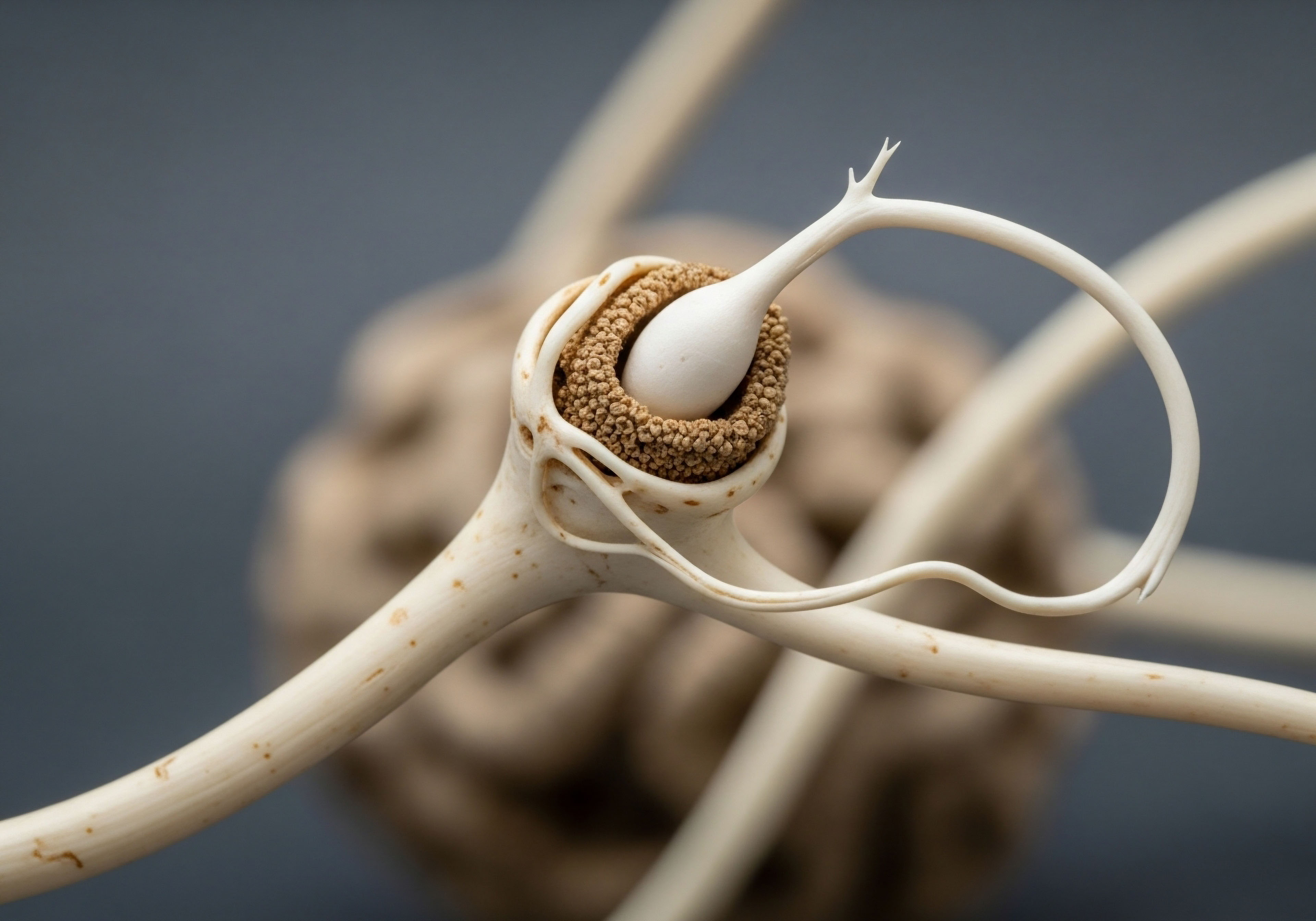

Fundamentals
The feeling is unmistakable. It is a subtle, creeping exhaustion that sleep does not seem to touch. It is a fog that clouds your thoughts, a frustrating shift in your body’s composition despite your best efforts with diet and exercise, or a quiet dimming of your own vitality.
Your experience is the starting point of this entire conversation. It is the human data that matters most, the subjective reality that lab values and clinical terminology must ultimately serve. You are here because you are seeking to understand the intricate internal symphony of your own body and to learn how you might restore its intended harmony.
The question of whether targeted peptide therapies can effectively restore natural hormonal balance is a deeply personal one, rooted in this desire to feel like yourself again.
To begin this exploration, we must first establish a shared language and a foundational map of the territory within. Your body operates as a magnificent, interconnected communication network. The endocrine system is the primary architect of this network, a collection of glands that produce and secrete hormones.
These hormones are powerful chemical messengers, traveling through the bloodstream to instruct cells and organs on their specific functions. They regulate everything from your metabolism and growth to your mood and sleep cycles. Think of this system as the body’s internal messaging service, constantly sending updates and commands to maintain a state of dynamic equilibrium known as homeostasis.
The endocrine system functions as the body’s primary communication network, using hormones as chemical messengers to maintain internal balance.
At the heart of this network are feedback loops, elegant biological circuits that ensure no single hormonal signal becomes too strong or too weak. The most relevant of these for our discussion is the Hypothalamic-Pituitary-Gonadal (HPG) axis. This axis represents a continuous conversation between three key endocrine players:
- The Hypothalamus This is the command center, located deep within your brain. It constantly monitors your body’s internal environment and hormonal levels. When it detects a need, it releases a specific signaling molecule, Gonadotropin-Releasing Hormone (GnRH).
- The Pituitary Gland Often called the “master gland,” the pituitary sits just below the hypothalamus. When it receives the GnRH signal, it responds by releasing its own set of hormones, primarily Luteinizing Hormone (LH) and Follicle-Stimulating Hormone (FSH).
- The Gonads These are the testes in men and the ovaries in women. When stimulated by LH and FSH, they produce the primary sex hormones ∞ testosterone in men, and estrogen and progesterone in women.
This entire cascade is regulated by negative feedback. As testosterone or estrogen levels rise in the blood, the hypothalamus and pituitary detect this increase and reduce their output of GnRH, LH, and FSH. This sophisticated mechanism works much like a thermostat in your home.
When the temperature reaches the desired set point, the furnace shuts off. When it drops, the furnace kicks back on. This process ensures that hormonal levels are kept within a precise, healthy range. When this axis is disrupted by age, stress, or other factors, the entire system can become dysregulated, leading to the very symptoms that prompted your search for answers.

What Are Peptides?
With this understanding of the body’s hormonal architecture, we can now introduce the concept of peptides. Peptides are small proteins, short chains of amino acids linked together. Your body naturally produces thousands of them, and they perform a vast array of functions. Some act as neurotransmitters, others as hormones themselves.
The key characteristic of a peptide is its specificity. Like a key designed for a single lock, a specific peptide will bind to a specific receptor on a cell’s surface, delivering a precise instruction. Targeted peptide therapies leverage this specificity.
They are designed to mimic or influence the body’s natural signaling molecules, providing a way to interact with and modulate the endocrine system with remarkable precision. They can be used to restart a conversation that has faltered, to amplify a signal that has grown weak, or to restore a rhythm that has been lost. This approach is about working with the body’s own communication pathways to encourage a return to its natural state of balance and function.


Intermediate
Understanding the body’s hormonal communication network provides the foundation for exploring how we can actively and precisely influence it. Targeted peptide therapies represent a sophisticated clinical strategy for recalibrating this system. This approach involves using specific amino acid chains to interact with the body’s own control mechanisms, particularly the Hypothalamic-Pituitary-Gonadal (HPG) axis and growth hormone pathways.
The goal is to restore physiological function by prompting the body to regenerate its own optimal hormonal environment. Here, we will examine the specific clinical protocols and the biological rationale behind their application for both men and women.

Growth Hormone Peptide Therapy
One of the most common areas of hormonal optimization involves addressing the age-related decline in growth hormone (GH). Direct administration of synthetic human growth hormone (HGH) can be effective, yet it overrides the body’s natural regulatory feedback loops, which can lead to unwanted side effects.
Growth hormone peptide therapies present a more nuanced approach. They do not supply the body with external GH; instead, they stimulate the pituitary gland to produce and release its own GH in a manner that respects the body’s natural pulsatile rhythm. This is accomplished through two primary classes of peptides.

GHRH Analogs Sermorelin and CJC 1295
Growth Hormone-Releasing Hormone (GHRH) is the signal the hypothalamus sends to the pituitary to trigger GH release. Sermorelin and CJC-1295 are synthetic analogs of GHRH. They bind to the same GHRH receptors on the pituitary gland, effectively mimicking the natural signal from the brain.
Sermorelin is a short-acting peptide that promotes a quick, clean pulse of GH. CJC-1295 is a modified version with a longer half-life, especially when it includes a component called Drug Affinity Complex (DAC), which allows it to bind to proteins in the blood and remain active for days. This provides a sustained elevation in overall GH and, consequently, Insulin-like Growth Factor 1 (IGF-1) levels, which is the primary mediator of GH’s effects on tissue growth and repair.

Ghrelin Mimetics Ipamorelin and Hexarelin
The second class of peptides works on a parallel pathway. Ghrelin is a hormone primarily known for stimulating hunger, but it also potently stimulates GH release by binding to the Growth Hormone Secretagogue Receptor (GHS-R) in the pituitary. Ipamorelin and Hexarelin are ghrelin mimetics; they activate this same receptor to induce a strong pulse of GH.
Ipamorelin is highly valued for its specificity, as it stimulates GH release with minimal to no impact on other hormones like cortisol or prolactin. This makes it a very clean and targeted therapy. Often, a GHRH analog like CJC-1295 is combined with a ghrelin mimetic like Ipamorelin.
This dual-action approach stimulates the pituitary through two different receptor pathways simultaneously, resulting in a synergistic and powerful release of natural growth hormone that is greater than the effect of either peptide alone.
Combining a GHRH analog with a ghrelin mimetic creates a synergistic effect, stimulating a more potent release of the body’s own growth hormone.
The table below compares some of the key peptides used for stimulating growth hormone production.
| Peptide | Mechanism of Action | Primary Benefits | Typical Administration |
|---|---|---|---|
| Sermorelin | GHRH Analog | Increases natural GH pulse, improves sleep, supports metabolism | Daily subcutaneous injection |
| CJC-1295 with DAC | Long-acting GHRH Analog | Sustained increase in GH and IGF-1, promotes fat loss and muscle gain | Subcutaneous injection 1-2 times per week |
| Ipamorelin | Selective Ghrelin Mimetic (GHS-R Agonist) | Strong, clean GH pulse, improves recovery, sleep, and body composition | Daily subcutaneous injection, often with CJC-1295 |
| Tesamorelin | GHRH Analog | Potent GH release with specific efficacy in reducing visceral adipose tissue | Daily subcutaneous injection |

Testosterone Replacement Therapy Protocols
For individuals experiencing the symptoms of low testosterone, known as hypogonadism or andropause in men, direct hormone replacement is often the most effective path. The goal of modern protocols is to restore testosterone levels to an optimal physiological range while maintaining the overall balance of the endocrine system. This requires a multi-faceted approach.

How Can TRT Protocols Be Optimized for Men?
A standard, effective protocol for men involves more than just testosterone. It is a carefully constructed regimen designed to optimize outcomes and mitigate potential side effects.
- Testosterone Cypionate This is a bioidentical form of testosterone attached to an ester, which allows for a slow and steady release into the bloodstream. Weekly intramuscular injections are a common and highly effective delivery method, providing stable testosterone levels without the daily fluctuations of gels or creams.
- Gonadorelin When the body receives external testosterone, its own production shuts down. The hypothalamus stops sending the GnRH signal, the pituitary stops releasing LH and FSH, and the testes become dormant. This leads to testicular atrophy (shrinkage) and a loss of endogenous hormonal function. Gonadorelin is a bioidentical GnRH. By administering small, pulsatile doses via subcutaneous injection (typically twice weekly), the protocol keeps the pituitary stimulated. This preserves the integrity of the HPG axis, maintaining testicular size and function even while on TRT. This is particularly important for younger men who may wish to preserve fertility.
- Anastrozole Testosterone can be converted into estrogen through a process called aromatization. In men, elevated estrogen levels can lead to side effects like water retention, moodiness, and gynecomastia (the development of breast tissue). Anastrozole is an aromatase inhibitor, an oral medication taken to block this conversion, thereby keeping estrogen levels in a healthy, balanced range.

What Are the Hormonal Needs of Women?
Women’s hormonal health is a complex interplay of estrogen, progesterone, and testosterone. As women enter perimenopause and post-menopause, the decline and fluctuation of these hormones can cause a wide range of debilitating symptoms. While estrogen and progesterone replacement are well-known, the critical role of testosterone in female health is often overlooked. Low testosterone in women can contribute to low libido, fatigue, depression, and difficulty building muscle mass. Thoughtful protocols can address these deficiencies.
- Testosterone Cypionate Women benefit from testosterone optimization, though at much lower doses than men. Small, weekly subcutaneous injections of Testosterone Cypionate (typically 10-20 units) can restore energy, libido, and a sense of well-being without causing masculinizing side effects.
- Progesterone Progesterone is a crucial hormone for women, particularly those who still have a uterus, as it balances the effects of estrogen. It also has calming, pro-sleep effects. Its use is tailored to a woman’s menopausal status, often prescribed as a nightly oral capsule to support sleep and hormonal equilibrium.

Other Targeted Peptide Applications
The specificity of peptides allows for their application in highly targeted areas beyond general hormonal balance, addressing specific functions like tissue repair and sexual health.

PT-141 for Sexual Health
PT-141, also known as Bremelanotide, is a unique peptide that works directly on the nervous system to increase sexual arousal. It is an analog of alpha-melanocyte-stimulating hormone (α-MSH) and activates melanocortin receptors in the brain. This mechanism is distinct from medications that work by increasing blood flow. PT-141 influences the pathways of sexual desire itself, making it an effective treatment for both men with erectile dysfunction and women with hypoactive sexual desire disorder.

BPC-157 for Tissue Repair
Body Protection Compound 157 (BPC-157) is a pentadecapeptide derived from a protein found in human gastric juice. It has demonstrated powerful regenerative properties across a wide range of tissues, including muscle, tendon, ligament, and bone. Its primary mechanism involves promoting angiogenesis, the formation of new blood vessels, which is critical for delivering oxygen and nutrients to injured tissue.
BPC-157 also appears to upregulate growth hormone receptors on fibroblasts, the cells responsible for producing collagen, thereby enhancing the healing process. It is often used to accelerate recovery from injuries, reduce inflammation, and support gut health.


Academic
A sophisticated clinical application of peptide therapies requires a systems-biology perspective, moving beyond the modulation of a single hormone to an appreciation of the entire interconnected neuroendocrine network. The efficacy of these interventions is rooted in their ability to precisely manipulate cellular signaling pathways and gene expression, aiming to restore homeostatic mechanisms that have been perturbed by age, injury, or metabolic dysfunction.
This section delves into the molecular underpinnings of these therapies, focusing on the pharmacokinetics of advanced peptide formulations and the intricate interplay between the hormonal axes they influence. We will explore how these molecules are designed for specific biological effects and how their administration can be optimized to mimic endogenous physiological rhythms.

The Molecular Science of Growth Hormone Secretagogues
The therapeutic strategy of using Growth Hormone Secretagogues (GHS) is predicated on a foundational principle of endocrinology ∞ mimicking or amplifying endogenous signals is often preferable to exogenous replacement. This approach preserves the sensitive feedback loops that protect the organism from hormonal excess. The development of GHS has evolved along two distinct but complementary receptor-pathway systems ∞ the GHRH receptor (GHRH-R) and the ghrelin receptor, or Growth Hormone Secretagogue Receptor (GHS-R1a).

Pharmacokinetic Design CJC 1295 and Drug Affinity Complex
The evolution from native GHRH to Sermorelin (the first 29 amino acids of GHRH) and then to modified analogs like CJC-1295 illustrates a core challenge in peptide pharmacology ∞ overcoming rapid enzymatic degradation and clearance. Native GHRH has a half-life of only a few minutes. CJC-1295 represents a significant leap in bioengineering.
The “CJC-1295 without DAC” variant (also known as Mod GRF 1-29) involves four amino acid substitutions that make it more resistant to degradation, extending its half-life to about 30 minutes, allowing for a more effective pulsatile release of GH.
The true innovation, however, is the addition of the Drug Affinity Complex (DAC). This modification involves attaching a lysine linker to a reactive chemical group (maleimidopropionic acid) which, upon subcutaneous injection, allows the peptide to form a covalent bond with circulating albumin. Albumin is the most abundant protein in blood plasma and has a long half-life.
By binding to it, CJC-1295 with DAC effectively becomes a long-acting prodrug, protected from renal clearance and enzymatic breakdown. This extends its half-life to approximately 8 days, enabling a single weekly or bi-weekly injection to produce a sustained elevation of both baseline and peak GH levels, leading to a stable and significant increase in serum IGF-1. This pharmacokinetic profile is highly beneficial for long-term anabolic support, collagen synthesis, and lipolysis.

Signal Transduction and Synergism Ipamorelin and CJC 1295
The synergistic effect observed when combining a GHRH analog with a ghrelin mimetic is a direct result of activating two distinct intracellular signaling cascades within the same pituitary somatotroph cells. GHRH-R activation primarily works through the Gs alpha subunit, increasing intracellular cyclic AMP (cAMP) and activating Protein Kinase A (PKA).
This pathway promotes the synthesis and release of GH. In contrast, GHS-R1a activation by a ligand like Ipamorelin couples to the Gq alpha subunit, activating Phospholipase C (PLC). This leads to the generation of inositol trisphosphate (IP3) and diacylglycerol (DAG), which increases intracellular calcium concentrations and activates Protein Kinase C (PKC).
The concurrent activation of both the cAMP/PKA and the PLC/PKC pathways results in a massive influx of calcium and a powerful, coordinated exocytosis of GH-containing vesicles, producing a release that is supra-additive ∞ greater than the sum of the individual effects. Ipamorelin’s high specificity for the GHS-R1a, without significantly affecting cortisol or prolactin, makes this combination a clean and potent tool for restoring youthful GH pulsatility.
The concurrent activation of distinct intracellular signaling cascades by GHRH analogs and ghrelin mimetics results in a supra-additive release of growth hormone.

Restoring Axis Integrity the Role of Gonadorelin in TRT
The introduction of exogenous testosterone initiates a predictable shutdown of the HPG axis via negative feedback. This is a homeostatic mechanism designed to prevent hormonal excess. However, for a patient on long-term TRT, this shutdown results in testicular desensitization and atrophy, making it difficult to ever restore endogenous production. The use of Gonadorelin represents a sophisticated strategy to counteract this effect by maintaining the functional integrity of the axis.

Why Does Pulsatile Administration Matter?
The hypothalamus naturally releases GnRH in discrete pulses, approximately every 90-120 minutes. This pulsatility is critical. The GnRH receptors on the pituitary are designed to respond to these intermittent signals. Continuous, non-pulsatile exposure to GnRH (or a long-acting analog) leads to receptor downregulation and desensitization, paradoxically shutting down LH and FSH production.
This is the mechanism by which drugs like Lupron are used for chemical castration. Gonadorelin, being a bioidentical GnRH with a short half-life, is perfectly suited for mimicking this natural rhythm. By administering it via subcutaneous injection two to three times per week, the protocol delivers intermittent “pings” to the pituitary, preventing receptor desensitization and keeping the LH and FSH production pathways active.
This ensures the testes continue to receive the signals required for spermatogenesis and intratesticular testosterone production, thereby preserving testicular volume and function.

Systemic Regeneration the Pleiotropic Effects of BPC 157
Body Protection Compound 157 is a peptide that exemplifies the concept of pleiotropy, exhibiting multiple beneficial effects across various tissue types through several mechanisms of action. While its use is still largely preclinical, the existing research points to a powerful role in tissue repair and regeneration.
The table below outlines the proposed mechanisms of action for BPC-157.
| Mechanism | Biological Effect | Therapeutic Implication |
|---|---|---|
| Upregulation of VEGF | Promotes angiogenesis (new blood vessel formation) | Increased blood flow to injured tissues, accelerating healing |
| Activation of eNOS | Increases production of Nitric Oxide (NO) | Vasodilation and modulation of blood flow |
| Upregulation of GH Receptors | Increases sensitivity of fibroblasts to Growth Hormone | Enhanced collagen synthesis and extracellular matrix repair |
| Modulation of Inflammatory Pathways | Reduces infiltration of inflammatory cells | Controls excessive inflammation that can impede healing |

How Does BPC 157 Accelerate Healing?
The pro-healing effects of BPC-157 appear to be mediated significantly through its interaction with the nitric oxide (NO) system and its influence on growth factor signaling. Animal studies have shown that BPC-157 can counteract both the damaging effects of NSAIDs on the gut and their impairment of tendon healing, likely by modulating NO pathways.
Its most intriguing mechanism may be its ability to upregulate growth hormone receptor expression on tendon fibroblasts. This finding suggests that BPC-157 acts as a “healing amplifier.” It does not directly cause cell proliferation but makes the cells responsible for repair more receptive to the body’s own endogenous growth signals.
This may explain its broad efficacy across different tissues. By increasing the sensitivity to growth hormone, BPC-157 potentiates the natural repair processes, leading to faster and more organized tissue regeneration, as observed in numerous animal models of muscle, tendon, and ligament injury. While robust human clinical trials are still needed, the preclinical evidence presents BPC-157 as a highly promising agent for regenerative medicine.

References
- Teichman, Sam L. et al. “Prolonged stimulation of growth hormone (GH) and insulin-like growth factor I secretion by CJC-1295, a long-acting analog of GH-releasing hormone, in healthy adults.” The Journal of Clinical Endocrinology & Metabolism, vol. 91, no. 3, 2006, pp. 799-805.
- Ionescu, M. and L. A. Frohman. “Pulsatile secretion of growth hormone (GH) persists during continuous stimulation by CJC-1295, a long-acting GH-releasing hormone analog.” The Journal of Clinical Endocrinology & Metabolism, vol. 91, no. 12, 2006, pp. 4792-4797.
- Raun, K. et al. “Ipamorelin, the first selective growth hormone secretagogue.” European Journal of Endocrinology, vol. 139, no. 5, 1998, pp. 552-561.
- Falzone, N. et al. “The effect of Tesamorelin on visceral fat, inflammation and cardiovascular risk.” Expert Opinion on Investigational Drugs, vol. 19, no. 7, 2010, pp. 903-913.
- Bhasin, S. et al. “Testosterone therapy in men with androgen deficiency syndromes ∞ an Endocrine Society clinical practice guideline.” The Journal of Clinical Endocrinology & Metabolism, vol. 95, no. 6, 2010, pp. 2536-2559.
- Seiwerth, S. et al. “BPC 157 and Standard Angiogenic Growth Factors. Gut-Tendon Healing, Lesions and Tendon Healing.” Current Pharmaceutical Design, vol. 24, no. 18, 2018, pp. 1972-1989.
- Chang, C. H. et al. “Pentadecapeptide BPC 157 enhances the growth hormone receptor expression in tendon fibroblasts.” Molecules, vol. 19, no. 11, 2014, pp. 19066-19077.
- Gwyer, D. et al. “Gastric pentadecapeptide body protection compound BPC 157 and its role in accelerating musculoskeletal soft tissue healing.” Cell and Tissue Research, vol. 377, no. 2, 2019, pp. 153-159.
- De-Melo, B. S. et al. “The role of gonadorelin in male testosterone replacement therapy.” Journal of Human Reproductive Sciences, vol. 12, no. 3, 2019, pp. 175-180.
- Faloon, W. “Tesamorelin ∞ A New Option for Abdominal Fat Reduction.” Life Extension Magazine, Oct. 2010.

Reflection
You arrived here carrying the weight of your own experience ∞ the fatigue, the fog, the feeling of being disconnected from your own vitality. The information presented across these sections is designed to serve as a map, translating that lived experience into the language of biology and clinical science.
It provides a framework for understanding the intricate communication network within you and the precise tools available to help restore its function. This knowledge is the first, most critical step. It shifts the dynamic from one of passive suffering to one of active, informed participation in your own health.
Your journey forward is unique to you. The path to reclaiming your vitality is paved with this understanding, leading you toward choices that are aligned with your body’s specific needs and your personal goals for a life of uncompromising function.

Glossary

targeted peptide therapies

hormonal balance

endocrine system

peptide therapies

growth hormone

side effects

sermorelin

cjc-1295

drug affinity complex

growth hormone secretagogue receptor

ipamorelin

ghrelin mimetic

ghrh analog

subcutaneous injection

gonadorelin

anastrozole

pt-141

body protection compound 157

bpc-157

growth hormone secretagogue

distinct intracellular signaling cascades

hpg axis

trt

body protection compound




